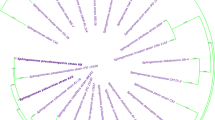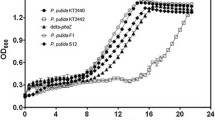Abstract
Actinomycetes are the most important microorganisms for the industrial production of secondary metabolites with antimicrobial and anticancer properties. However, they have not been implicated in biorefineries. Here, we study the ability of the ε-poly-l-lysine producing Streptomyces albulus BCRC 11814 to utilize biodiesel-derived crude glycerol. S. albulus was cultured in a mineral medium supplemented with up to 10% w/v sodium chloride or potassium chloride, and with crude glycerol as the sole carbohydrate source. Under these conditions, the strain produced 0.1 g ε-poly-l-lysine per 1 g of biomass. RNA sequencing revealed upregulation of the ectoine biosynthetic pathway of S. albulus, which provides proof of halotolerance. S. albulus has several silent secondary metabolite biosynthetic clusters predicted within the genome. Based on the results, we conclude that S. albulus BCRC 11814 is a halotolerant microorganism capable of utilizing biodiesel-derived crude glycerol better than other actinomycetes included in the present study. S. albulus has the potential to be established as microbial platform production host for a range of high-value biological products.


Similar content being viewed by others
References
Almeida JR, Favaro LC, Quirino BF (2012) Biodiesel biorefinery: opportunities and challenges for microbial production of fuels and chemicals from glycerol waste. Biotechnol Biofuels 5:48. https://doi.org/10.1186/1754-6834-5-48
Bérdy J (2012) Thoughts and facts about antibiotics: where we are now and where we are heading. J Antibiot (Tokyo) 65:385–395. https://doi.org/10.1038/ja.2012.27
Borugadda VB, Goud VV (2012) Biodiesel production from renewable feedstocks: status and opportunities. Renew Sustain Energy Rev 16:4763–4784. https://doi.org/10.1016/j.rser.2012.04.010
BP Statistical Review of World Energy (2018). https://www.bp.com/content/dam/bp/en/corporate/pdf/energy-economics/statistical-review/bp-stats-review-2018-full-report.pdf. Accessed 21 June 2018
Chen X, Mao Z (2013) Comparison of glucose and glycerol as carbon sources for ε-poly-l-lysine production by Streptomyces sp. M-Z18. Appl Biochem Biotechnol 170:185–197. https://doi.org/10.1007/s12010-013-0167-5
Ciriminna R, Della Pina C, Rossi M, Pagliaro M (2014) Understanding the glycerol market. Eur J Lipid Sci Technol 116:1–8. https://doi.org/10.1002/ejlt.201400229
Cray JA, Stevenson A, Ball P, Bankar SB, Eleutherio EC, Ezeji TC, Singhal RS, Thevelein JM, Timson DJ, Hallsworth JE (2015) Chaotropicity: a key factor in product tolerance of biofuel-producing microorganisms. Curr Opin Biotechnol 33:228–259. https://doi.org/10.1016/j.copbio.2015.02.010
da Silva GP, Mack M, Contiero J (2009) Glycerol: a promising and abundant carbon source for industrial microbiology. Biotechnol Adv 27:30–39. https://doi.org/10.1016/j.biotechadv.2008.07.006
de Lima Alves F, Stevenson A, Baxter E, Gillion JL, Hejazi F, Hayes S, Prior BA, McGenity TJ, Rangel DE, Magan N, Timmis KN, Hallsworth JE (2015) Concomitant osmotic and chaotropicity-induced stresses in Aspergillus wentii: compatible solutes determine the biotic window. Curr Genet 61:457–477. https://doi.org/10.1007/s00294-015-0496-8
Dobson R, Gray V, Rumbold K (2012) Microbial utilization of crude glycerol for the production of value-added products. J Ind Microbiol Biotechnol 39:217–226. https://doi.org/10.1007/s10295-011-1038-0
Dodd A, Swanevelder D, Featherston J, Rumbold K (2013) Draft genome sequence of Streptomyces albulus strain CCRC 11814, an ε-poly-l-lysine-producing actinomycete. Genome Announc 1:e00696-13. https://doi.org/10.1128/genomea.00696-13
Hallsworth JE, Heim S, Timmis KN (2003) Chaotropic solutes cause water stress in Pseudomonas putida. Environ Microbiol 5:1270–1280
Hamano Y (2010) Biochemistry and enzymology of poly-epsilon-l-lysine biosynthesis. In: Hamano Y (ed) Amino-acid homopolymers occurring in nature. Springer, Berlin, pp 23–44. https://doi.org/10.1007/978-3-642-12453-2_2
Hamano Y, Yoshida T, Kito M, Nakamori S, Nagasawa T, Takagi H (2006) Biological function of the pld gene product that degrades ε-poly-l-lysine in Streptomyces albulus. Appl Microbiol Biotechnol 72:173–181. https://doi.org/10.1007/s00253-006-0396-4
Hamedi J, Mohammadipanah F, Ventosa A (2013) Systematic and biotechnological aspects of halophilic and halotolerant actinomycetes. Extremophiles 17:1–13. https://doi.org/10.1007/s00792-012-0493-5
Hirohara H, Takehara M, Saimura M, Masayuki A, Miyamoto M (2006) Biosynthesis of poly(ε-l-lysine)s in two newly isolated strains of Streptomyces sp. Appl Microbiol Biotechnol 73:321–331. https://doi.org/10.1007/s00253-006-0479-2
Hoshino Y, Nakamori S, Takagi H (2003) Cloning and analysis of the β-lactamase gene from ε-poly-l-lysine-Producing actinomycete Streptomyces albulus IFO14147. J Biochem 134:473–478
Kahar P, Iwata T, Hiraki J, Park EY, Okabe M (2001) Enhancement of ε-polylysine production by Streptomyces albulus strain 410 using pH control. J Biosci Bioeng 91:190–194
Knocke C, Vogt J (2009) Biofuels—challenges & chances: how biofuel development can benefit from advanced process technology. Eng Life Sci 9:96–99. https://doi.org/10.1002/elsc.200700064
Kol S, Elena Merlo M, Scheltema RA, De Vries M, Vonk RJ, Kikkert NA, Dijkhuizen L, Breitling R, Takano E (2010) Metabolomic characterization of the salt stress response in Streptomyces coelicolor. Appl Environ Microbiol 76:2574–2581. https://doi.org/10.1128/aem.01992-09
Lee CS, Aroua MK, Daud WMAW, Cognet P, Pérès-Lucchese Y, Fabre PL, Reynes O, Latapie L (2015) A review: conversion of bioglycerol into 1,3-propanediol via biological and chemical method. Renew Sustain Energy Rev 42:963–972. https://doi.org/10.1016/j.rser.2014.10.033
Martínez-Gómez K, Flores N, Castañeda HM, Martínez-Batallar G, Hernández-Chávez G, Ramírez OT et al (2012) New insights into Escherichia coli metabolism: carbon scavenging, acetate metabolism and carbon recycling responses during growth on glycerol. Microb Cell Fact 11:46. https://doi.org/10.1186/1475-2859-11-46
Mu Y, Teng H, Zhang D, Wang W, Xiu Z (2006) Microbial production of 1,3-propanediol by Klebsiella pneumoniae using crude glycerol from biodiesel preparations. Biotechnol Lett 28:1755–1759. https://doi.org/10.1007/s10529-006-9154-z
Mustakhimov II, Reshetnikov AS, Khmelenina VN, Trotsenko YA (2010) Regulatory aspects of ectoine biosynthesis in halophilic bacteria. Microbiology 79:583–592. https://doi.org/10.1134/s0026261710050024
Paterson G, Turner D, Wiese L, Van Zijl G, Clarke C, Van Tol J (2015) Spatial soil information in South Africa: situational analysis, limitations and challenges. S Afr J Sci 111:1–7. https://doi.org/10.17159/sajs.2015/20140178 (Art.#2014-0178)
Reina-Bueno M, Argandoña M, Salvador M, Rodríguez-Moya J, Iglesias-Guerra F, Csonka LN, Nieto JJ, Vargas C (2012) Role of trehalose in salinity and temperature tolerance in the model halophilic bacterium Chromohalobacter salexigens. PLoS ONE 7:e33587. https://doi.org/10.1371/journal.pone.0033587
Rumbold K, Van Buijsen HJJ, Overkamp KM, Van Groenestijn JM, Punt PJ, Van Der Werf MJ (2009) Microbial production host selection for converting second-generation feedstocks into bioproducts. Microb Cell Fact 8:64. https://doi.org/10.1186/1475-2859-8-64
Schwibbert K, Marin-Sanguino A, Bagyan I, Heidrich G, Lentzen G, Seitz H, Rampp M, Schuster SC, Klenk HP, Pfeiffer F, Oesterhelt D, Kunte HJ (2011) A blueprint of ectoine metabolism from the genome of the industrial producer Halomonas elongata DSM 2581T. Environ Microbiol 13:1973–1994. https://doi.org/10.1111/j.1462-2920.2010.02336.x
Shen WC, Yang D, Ryser HJ (1984) Colorimetric determination of microgram quantities of polylysine by trypan blue precipitation. Anal Biochem 142:521–524
Shima S, Matsuoka H, Iwamoto T, Sakai H (1984) Antimicrobial action of epsilon-poly-l-lysine. J Antibiot (Tokyo) 37:1449–1455
Shukla SC, Singh A, Pandey AK, Mishra A (2012) Review on production and medical applications of ε-polylysine. Biochem Eng J 65:70–81. https://doi.org/10.1016/j.bej.2012.04.001
Stevenson A, Hallsworth JE (2014) Water and temperature relations of soil Actinobacteria. Environ Microbiol Rep 6:744–755
Stevenson A, Cray JA, Williams JP, Santos R, Sahay R, Neuenkirchen N, McClure CD, Grant IR, Houghton JD, Quinn JP, Timson DJ, Patil SV, Singhal RS, Antón J, Dijksterhuis J, Hocking AD, Lievens B, Rangel DE, Voytek MA, Gunde-Cimerman N, Oren A, Timmis KN, McGenity TJ, Hallsworth JE (2015) Is there a common water-activity limit for the three domains of life? ISME J 9:1333–1351. https://doi.org/10.1038/ismej.2014.219
Stevenson A, Hamill PG, Medina Á, Kminek G, Rummel J, Dijksterhuis J, Timson DJ, Magan N, Leong SL, Hallsworth JE (2017) Glycerol enhances fungal germination at the water- activity limit for life. Environ Microbiol 19:947–967. https://doi.org/10.1111/1462-2920.13530
Stevenson A, Hamill PG, O’Kane CJ, Kminek G, Rummel JD, Voytek MA, Dijksterhuis J, Hallsworth JE (2017) Aspergillus penicillioides differentiation and cell division at 0.585 water activity. Environ Microbiol 19:687–697. https://doi.org/10.1111/1462-2920.13597
Thompson JC, He BB (2006) Characterization of crude glycerol from biodiesel production from multiple feedstocks. Appl Eng Agric 22:261–265
Weber T, Blin K, Duddela S, Krug D, Kim HU, Bruccoleri R, Lee SY, Fischbach MA, Müller R, Wohlleben W, Breitling R, Takano R, Medema MH (2015) antiSMASH 3.0—a comprehensive resource for the genome mining of biosynthetic gene clusters. Nucleic Acids Res 43:W237–W243. https://doi.org/10.1093/nar/gkv437
Yang F, Hanna M, Sun R (2012) Value-added uses for crude glycerol—a by-product of biodiesel production. Biotechnol Biofuels 5:13. https://doi.org/10.1186/1754-6834-5-13
Acknowledgements
We thank the National Research Foundation (NRF) and the Department of Science and Technology (DST) Biocatalysis Initiative for their financial assistance. The opinions expressed and conclusions arrived at are those of the authors and are not necessarily attributable to the NRF from whom Amanda Dodd received an Innovation Doctoral Scholarship (Grant ID 83765, National Research Foundation of South Africa). The authors have no conflict of interest to declare.
Author information
Authors and Affiliations
Corresponding author
Electronic supplementary material
Below is the link to the electronic supplementary material.
Rights and permissions
About this article
Cite this article
Dodd, A., Swanevelder, D., Zhou, N. et al. Streptomyces albulus yields ε-poly-l-lysine and other products from salt-contaminated glycerol waste. J Ind Microbiol Biotechnol 45, 1083–1090 (2018). https://doi.org/10.1007/s10295-018-2082-9
Received:
Accepted:
Published:
Issue Date:
DOI: https://doi.org/10.1007/s10295-018-2082-9




